





The purpose of this article is to give the reader some idea of what might be blooming in the succulent world this time of year (January) in the northern hemisphere. For those living south of the equator, add/subtract 6 months and the same flowering schedule should be accurate for you as well. Though January is over-represented by the Aloes, there are some other species blooming this month, too.
Throughout most of the U.S., there is not too much blooming the first month of the year as this is mid-winter for us north of the equator. Thankfully there are areas (such as where I live in southern California) that are not a frozen wasteland in January. There are actually are a number of succulent plants which have evolved so that January, the very middle of winter, is their preferred month of the entire year to produce their flowers. If December was dominated by aloe flowers, January is THE Aloe month with more species of Aloes blooming than in any other month (February second and probably March and December tied for third). I would guess that over 80% of all the aloes I grow bloom this month, though many may actually reach their blooming peak in February. A few Euphorbias, Crassulas and other odds and ends flower in January, but the overwhelming majority of succulents blooming the first month of the year are the Aloes. This article will only show give one a glimpse of the aloes blooming this month as there are just too many to include in such an article.
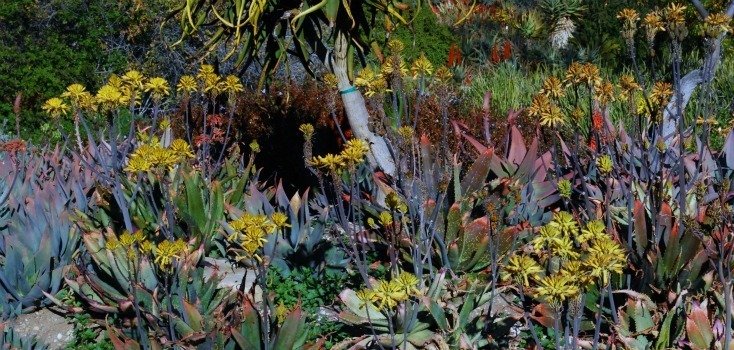
Scene from Los Angeles arboretum around the beginning of the year, showing primarily yellow-flowering Aloe maculatas
The Tree Aloes:
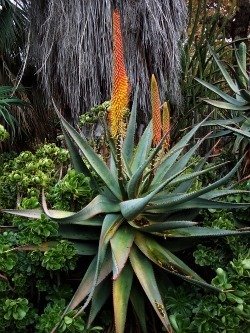
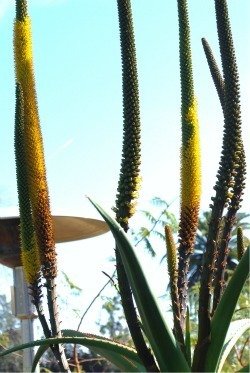
January is one of the biggest month for tree aloes, like Aloe africana (left) and Aloe alooides (right), both South African natives
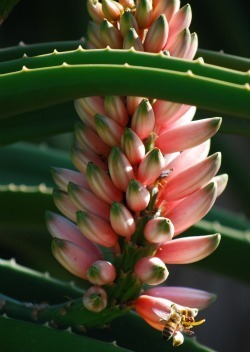
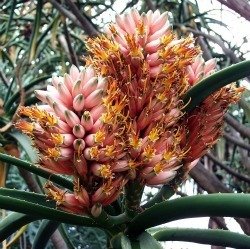
Aloe barberae (aka Aloe bainsii), the biggest aloe of them all, is also blooming primarily this month. These trees get up over thirty feet tall and nearly as wide
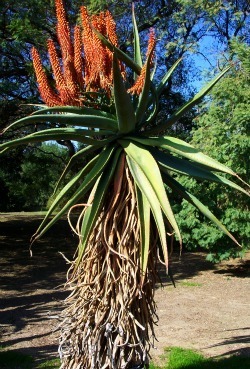
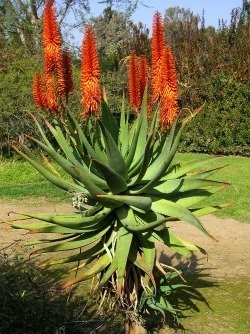
Aloe ferox (sometimes called Aloe candelabra, particularly if growing particuarly tall) also blooms mostly in January, though it can be seen blooming here and there for 3-4 months around winter
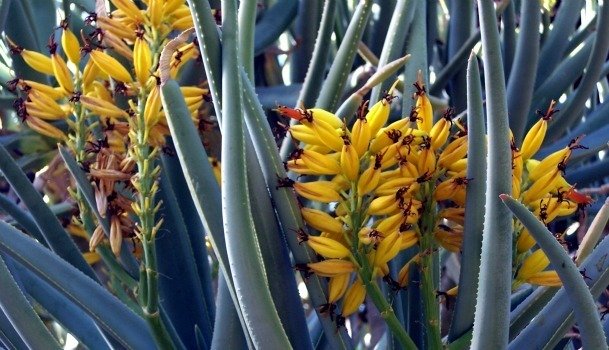
You may have seen last month's article on What's Blooming now, and seen Aloe dichotoma blooms in December. It blooms almost equally in January as well
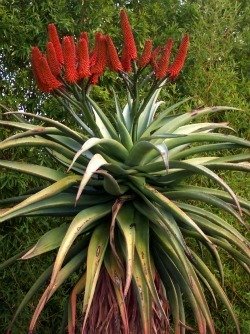
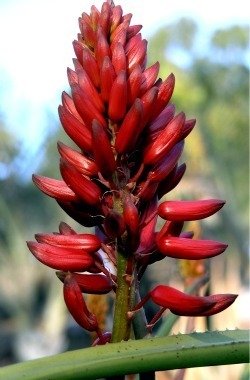
Aloe excelsa has some of the most deeply colored red flowers there are and is a prolific tree aloe bloomer for this and next month (left). Aloe eminens, a very rare tree aloe in cultivation, also blooms in January, but it may bloom in February as well. I just rarely get to see this growing anywhere at all (right). This flowering inflorescence is from a nice plant in a private collection in San Diego County, California. This plant may indeed be one of the only, if not the only, blooming Aloe eminens outside of Somalia. It is a very large tree and somewhat resembles Aloe barberae.
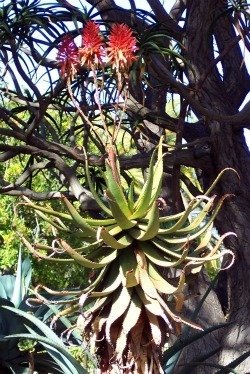
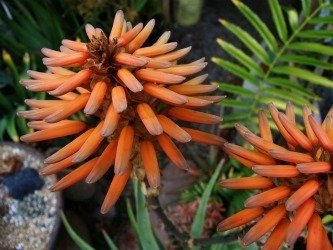
Aloe khamiesensis (left) is a spotted relatative of the much more common Aloe microstigma (also blooming this month- see below) but is more of a tree form and has branching infloresences; Aloe munchii (right) is one of my favorite tree aloes and this is it primary month for blooming(these flowers are from a plant in my yard)
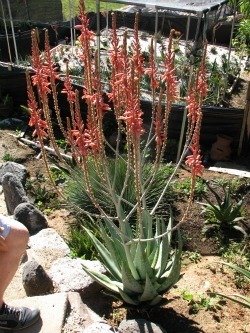
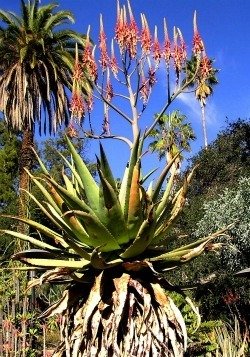
Aloe littoralis is a prolific bloomer and a reliable one, blooming even as a seedling (left) but eventually growing into a stately tree aloe (right)
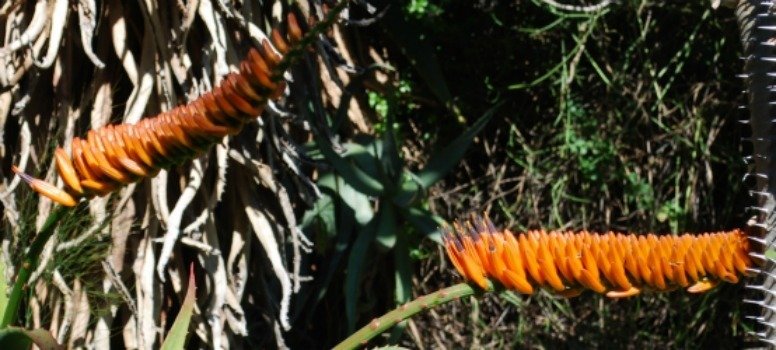
Aloe mawii flowers have a somewhat unique shape, with all the flowers growing up to the sky on laterally oriented inflorescensces
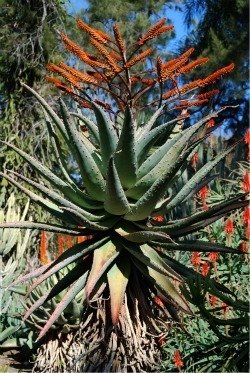
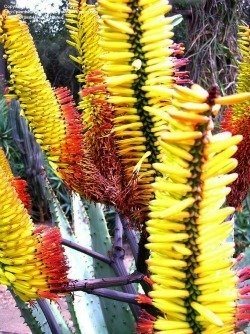
However, Aloe marlothii, a very common tree aloe, also has spectacular flowers that normally are also one-sided (facing to the sky) on multibranched inflorescences (left). There are other forms of Aloe marlothii, though, such as the KwaZulu form on the right, which have more yellow flowers and grow upright like most other aloe flowers. This form is also called Aloe spectabilis sometimes.
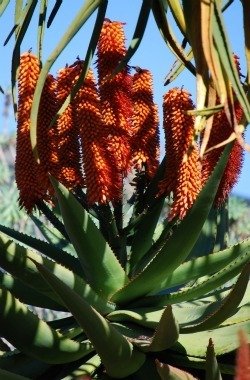
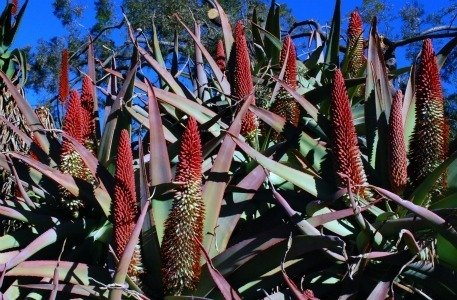
Aloes rupestris (left) and castanea (right) also sometimes can be found in bloom in January, but these are more primarily February bloomers in southern California

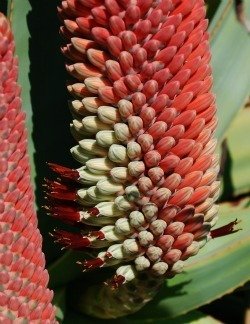
One of the most spectacular of all the blooming tree aloes is Aloe speciosa, which blooms, depending on the garden, anytime from very late December until March
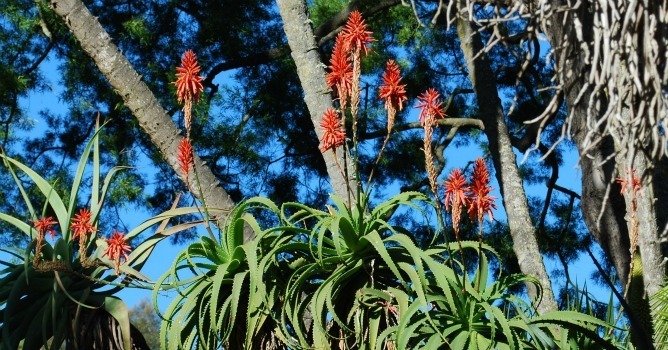
Aloe pluridens, the French Lace Aloe, is primarily in its blooming season in January.
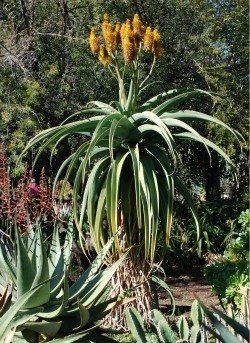
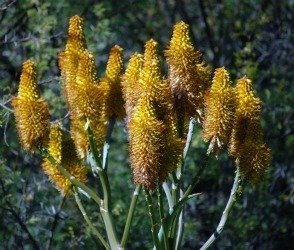
A classic tree aloe look, Aloe thraskii comes alive in January often with a huge head of glorious golden flowers
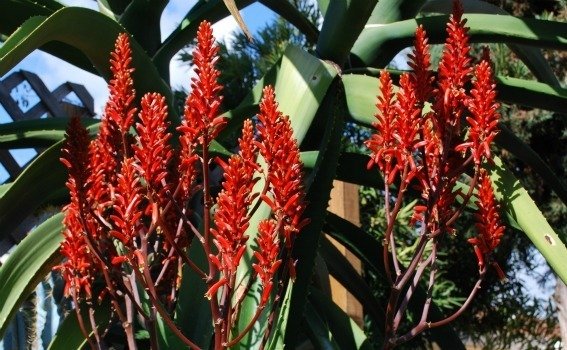
And one of my personal favorites (since it is so easy to grow and flowers so prolifically) is one of the best and most common of all the Madagascan tree aloes, Aloe vaombe (plant from my garden)
The Spotted or Maculate Aloes:
These include all the stemless or short-single-stemmed green, heavily spotted aloes. Why? Because for the most part, these all look alike with maybe only their flowers distinguishing them (somewhat). A few are included here as so many of these are blooming in January, but for those I skipped over, you can pretend you saw them as they look about the same.
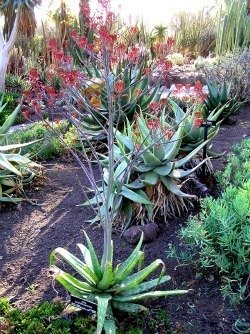
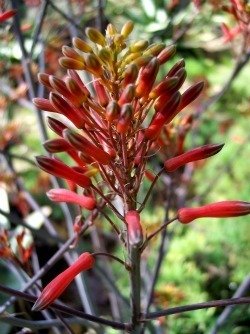
Aloe branddraaiensis, though a fairly ordinary looking spotted aloe, has one of the most highly branched inflorescences of all the aloes and is truly a magnificent bloomer in Janauary.
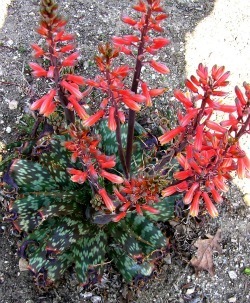
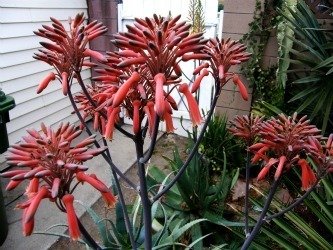
Aloe grandidentata (left) and Aloe greatheadii (right) are two of the more ordinary spotted aloes that crank out a flower this time of year. I find these both hard to tell apart, even from their flowers.
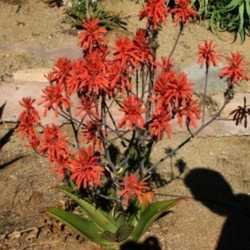
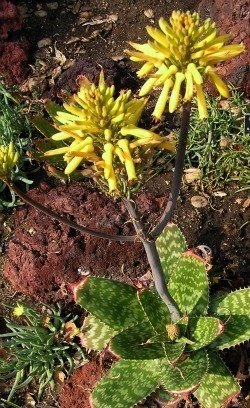
Aloe affinis, though basically a spotted aloe without many spots, has nicer than average flowers so I include it here
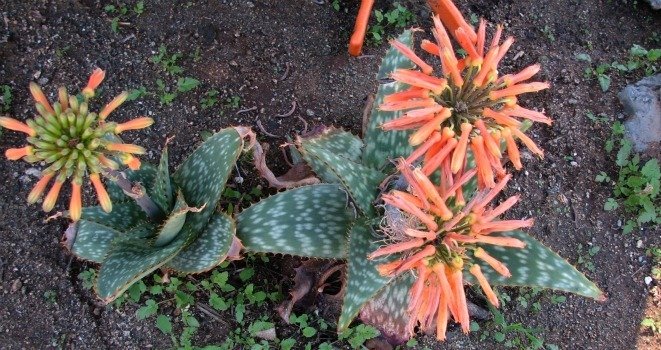

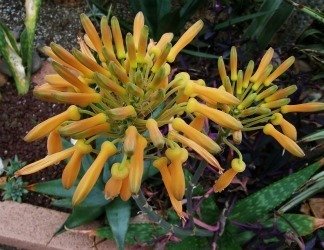
Aloe maculata is THE spotted aloe- extremely common all over the county, and flowers this month along with several other winter months. It comes in a variety of different flower colors from red, to orange to yellow.
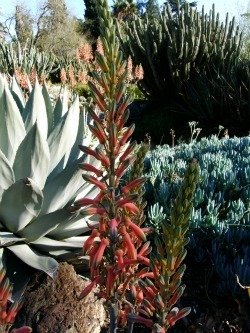
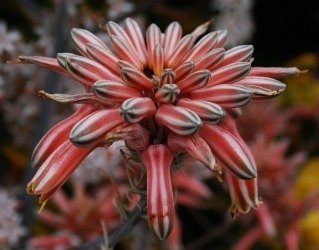
Aloe verdooniae flowers look a bit like those of several other spotted aloes (left), but those of Aloe petrophila are uniquely striped (right)
Shrubby, Bush Aloes:
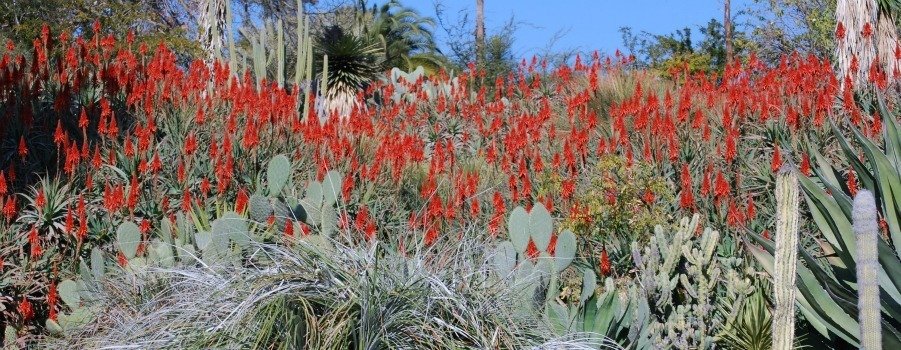
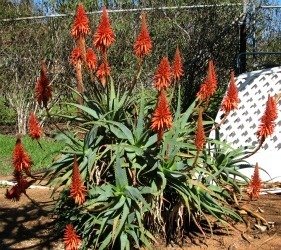
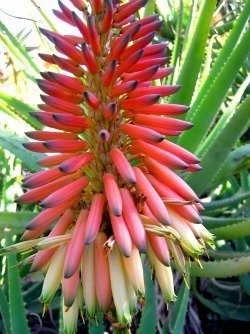
Aloe arborescens is blooming best in January (top and left), while Aloe mutabilis, a very similar looking larger shrub, is as well (right)
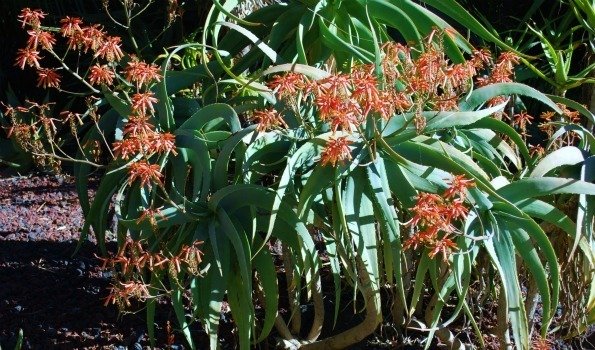
Aloe flexilifolia is a unique-looking stemmed, branching plant with characteristic 'drooping' leaves and nice red flowers in winter
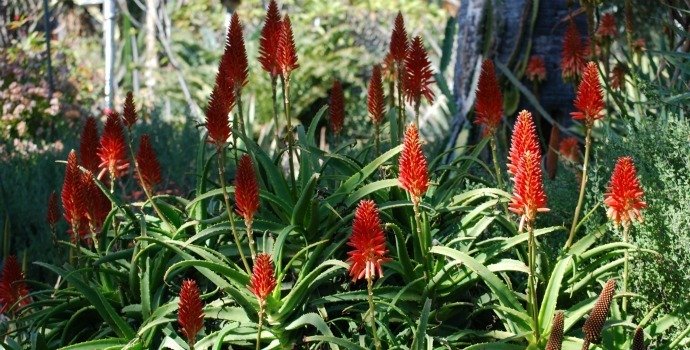
Another nice looking compact shrubby aloe that blooms in January is Aloe scorpioides
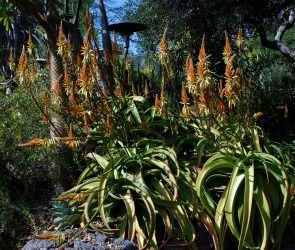
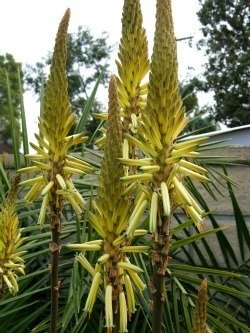
Aloe vanbalenii, also shown last month, blooms best and primarily in January
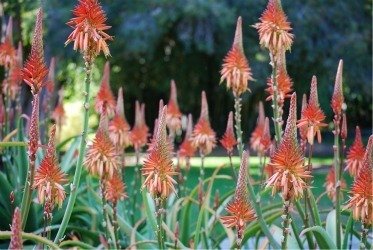
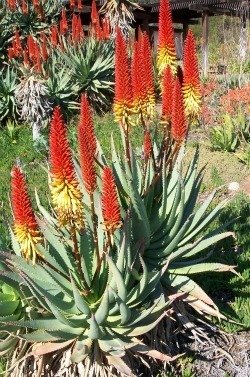
Some hybrid aloes bloom magically in January as well- Aloe 'Pink Perfection' (left) and a variable Aloe arborescens x ferox hybrid called Aloe 'Principes' (right)

several botanical gardens have massive plantings that bloom spectacularly of the Aloe 'Principies' variety (this in the Los Angeles arboretum)
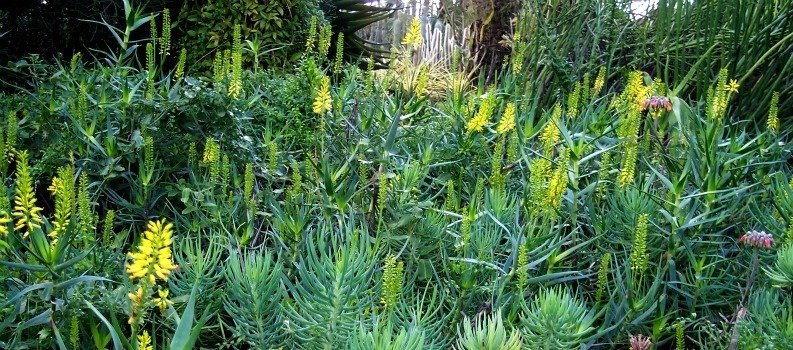
Another popular and commonly grown shrubby aloe that blooms in January, as it does much of the winter, is Aloe tenuior
Other Aloes:
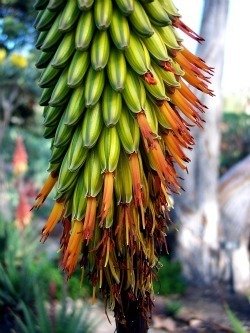
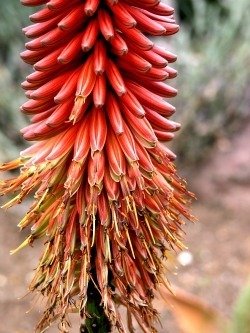

Aloe aculeata is one of my favorites- has several bloom color varieties, though red (left and center) is most common. This green (right) is from the Huntington in Southern California
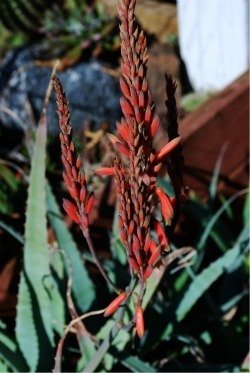
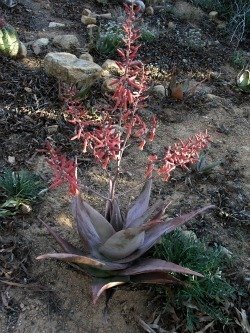
Aloe acutissima (from Madagascar- left) and Aloe ahmarensis (from Yemen- right)
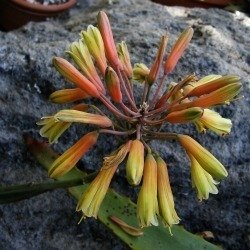
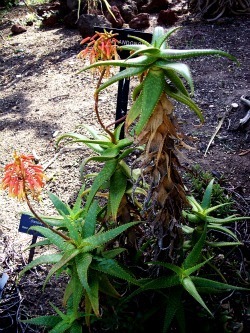
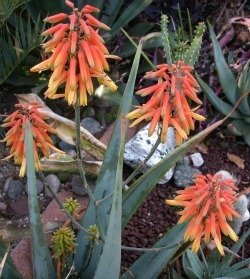
Aloe altimatsiatre from my garden (left) as is Aloe elegans (right); center photo is of Aloe andongensis from the Huntington, all in January
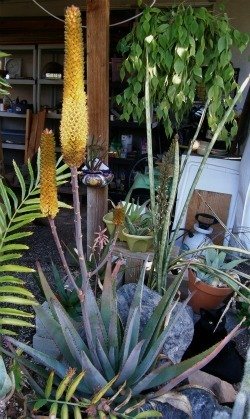
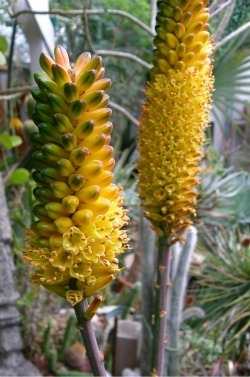
Aloe betsileensis is one of my favorites, too, having wonderful leaf color as well as interesting corn-cob-like flowers in winter- from my garden
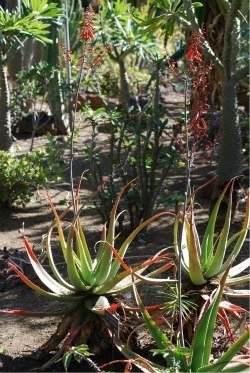
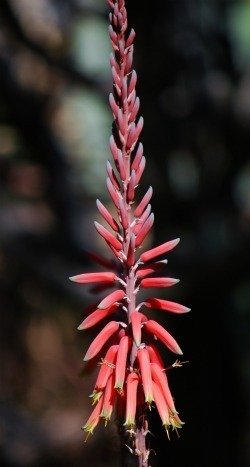
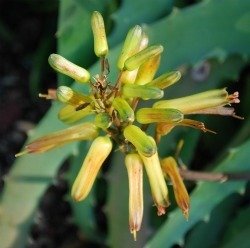
Aloe bulbolifera blooms in January, but flower stalks then hold the bulbils in February, a reproductive stage usually not seen in the genus Aloe (left); center is an Aloe bussei flower and right is a nice yellow flower from Aloe confusa
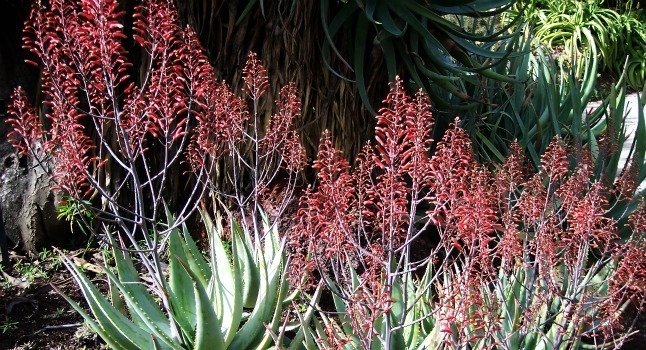
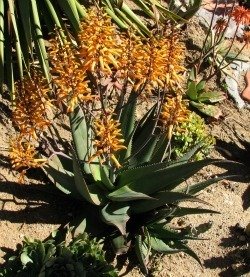
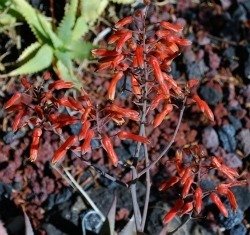
Aloe chabaudii is a popular aloe in many gardens as it is a prolific bloomer, producing many flowers from pink (above) to orange (left) and red (right)
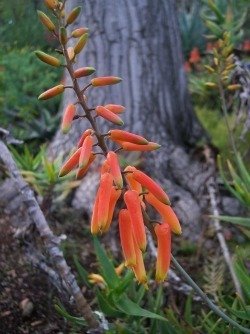
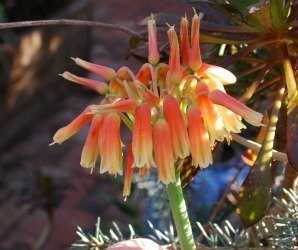
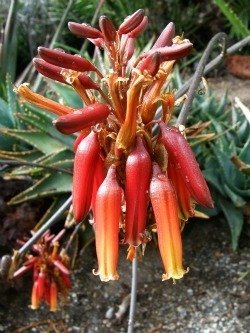
Aloes gracilis (left), hoffmannii (center) and harlana (right) are fairly rare findings in most gardens, but all have nice orange to red blooms in January
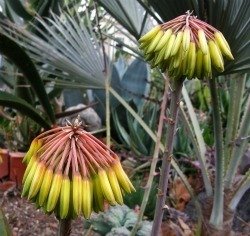
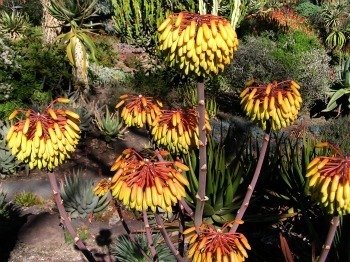
For variety of color and shape, Aloe capitata varieties are a nice addition to any succulent garden in a Mediterranean climate
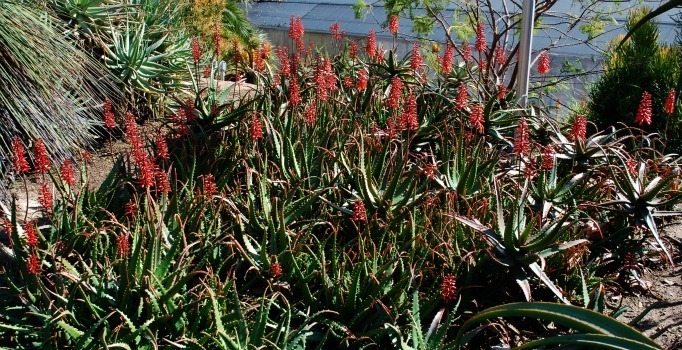
Aloe cameronii is one of the few aloes grown primarily for its amazing red colored foliage in times of stress. However, this colony above is obviously not too stressed as all the leaves are green. Still, it can be at least seen flowering red in January
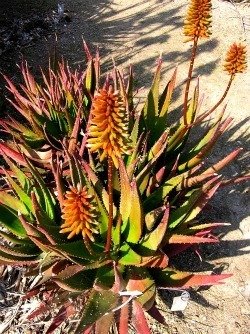
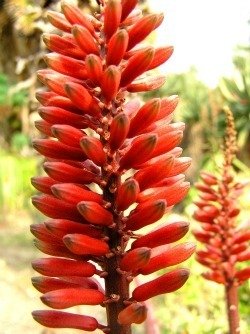
Plant on left is an Aloe cameronii at least showing some color changes, along with a slightly unusual flower color (orange); right is more typical flower color
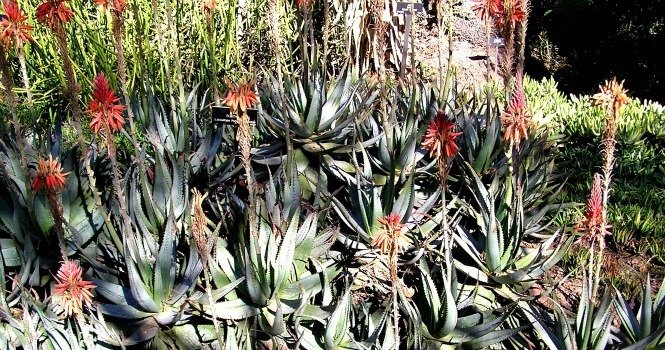
Aloe framesii is blooming in January at the Huntington
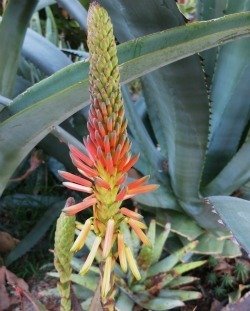
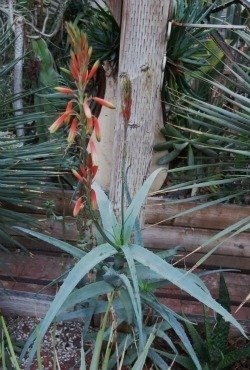
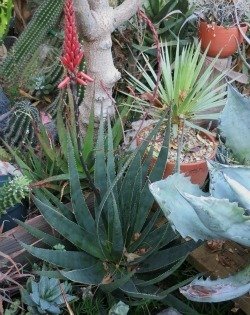
three aloes blooming in my yard in January: Aloe microstigma (closely related to Aloe framesii above)- left; Aloe decaryi (center) and Aloe succotrina, blooming for the first time this year (2012)- right
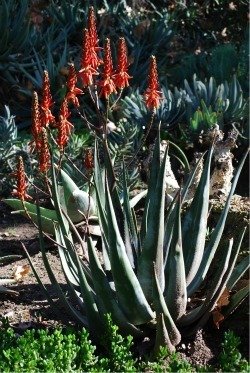
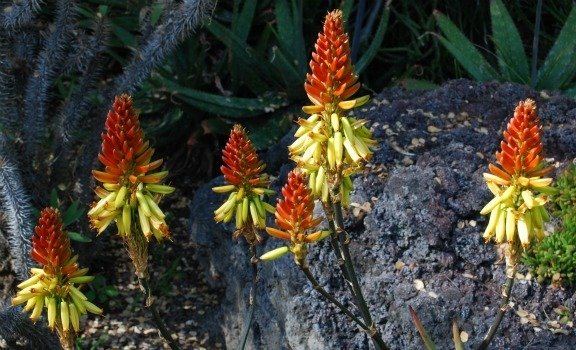
Two forms of Aloe cryptopoda can be seen blooming multiple times of the year, but January seems to be the biggest month. Plant on right is sometimes called Aloe wickensii
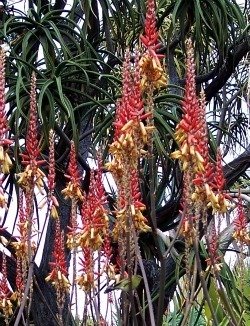
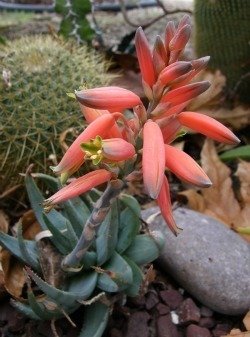
Aloe lutescens is one of the prolific and ornamental January bloomers (left) while Aloe krapohliana is one of the least (right)
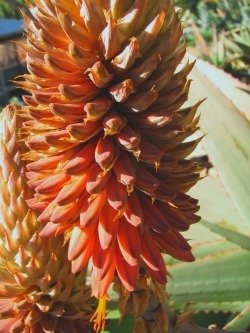
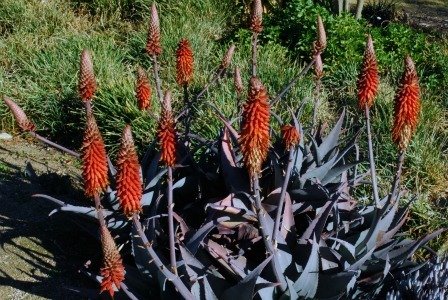
Aloe rubroviolacea usually blooms in my garden in March, but for some reason, this one blooms at significantly different times of the year depending on what garden it's growing in. These plants are growing in the Los Angeles Arboretum, where it always blooms in January.
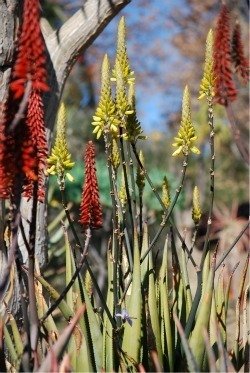
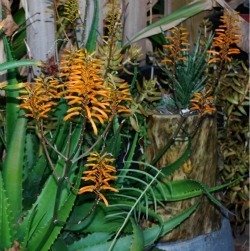
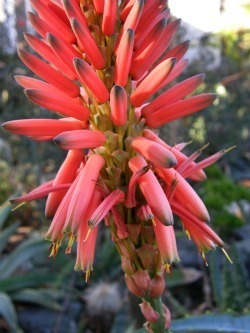
Aloe vera, the most common and well known aloe there is, blooms multiple times all year, but these ones on the left were blooming in January (note two color varieties); other two aloes are two of the more prolific bloomers in my yard, Aloe dawei (center) and Aloe hardyi (right)
Crassulaceae
This genus includes a lot of the succulents that grow in southern California and many are more active in the winter than the summer. However, growing activity does not necessarily translate into blooming activity. Echeverias for the most part bloom other times of the year despite their seeming happiest when it's not so hot out. Same for Dudleyas and many Crassulas. Aeoniums pretty much bloom whenever. But the Kalanchoes are definitely winter bloomers (see below).
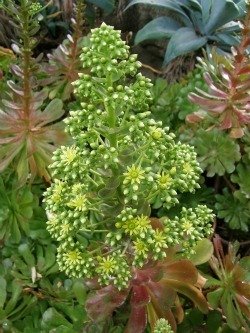
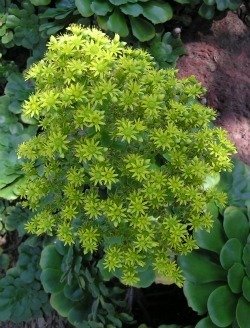
Aeoniums do their blooming throughout the year, though mostly in the cooler months. Here are just two I happened to see blooming in January
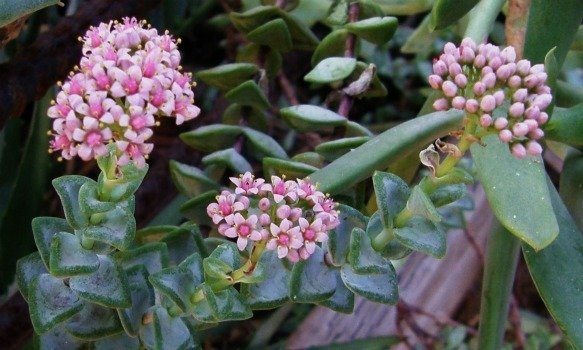
Crassula rupestris is definitely a January bloomer and all of them, no matter where they are in relation to the sun or if potted or not, bloom this month
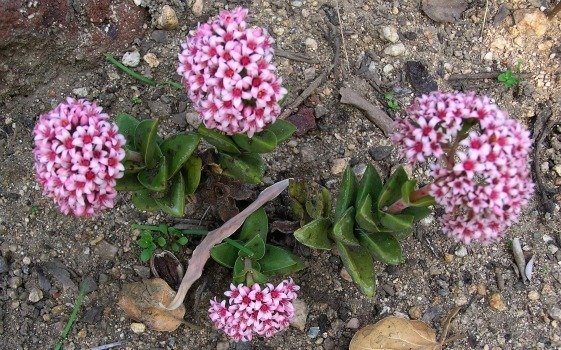
Crassula 'Springtime' blooms all year long, but mine are particularly happy this month
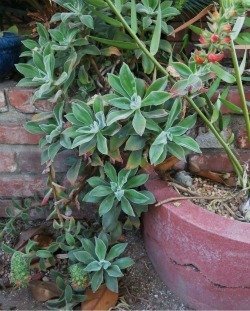
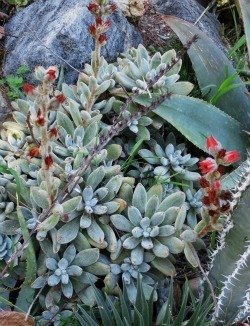
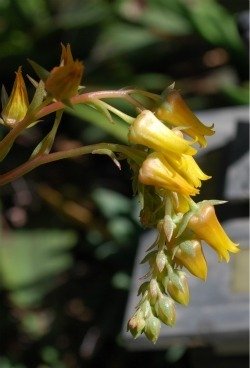
Though most my Echeverias bloom at other times, these three consistently bloom in January: Echeveria coccinea (left), Echeveria leuchotrica (center) and Echeveria agavoides
(right)
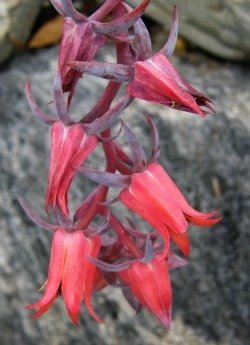
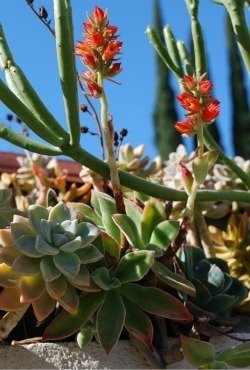
Echeveria hybrids (like this Echeveria 'Morning Light' flower off and on much of the year (left); right is Echeveria pulvinata, another fuzzy one that blooms in January
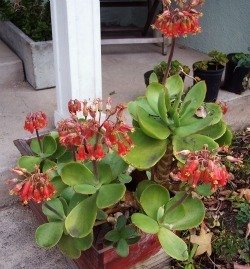
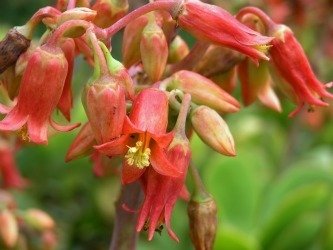
Cotyledon orbiculata, particularly this green form, usually bloom in January (though the bluer ones seem to be more variable bloomers)
As mentioned already, most Kalanchoes find January THE month to start their blooming cycles, and some of the more common species are seen below. Most Kalanchoes are monocarpic so the plant dies (or at least the portion flowering) after it flowers. There are some notable exceptions of course.
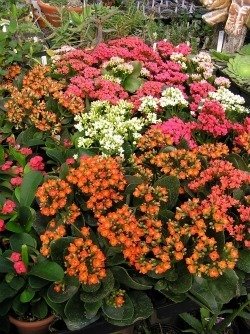
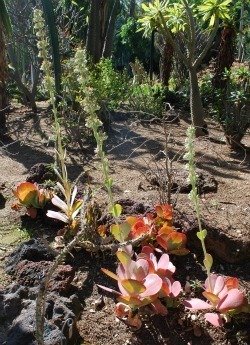
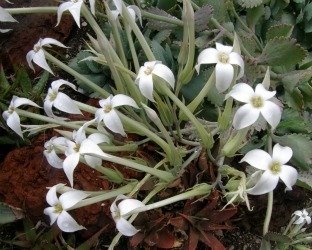
Kalanchoe blossfeldianas usually fill the nurseries this month (left); the Flapjack plant, Kalanchoe luciae, bloom this month as well (center), and another common Kalanchoe, Kalanchoe marmorata, the Penwiper Plant, blooms profusely this month (right)
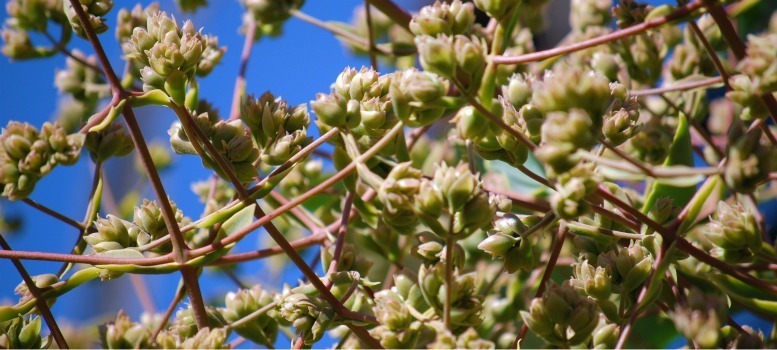
though perhaps not terribly ornamental flowers, Kalanchoe beharensis, one of the largest of all the Crassulaceae, produces massive blooms this month
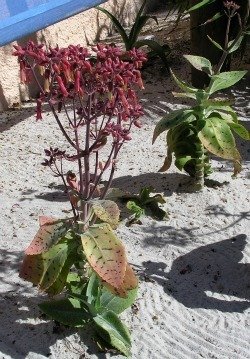
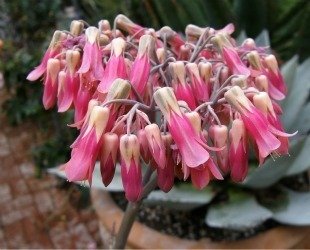
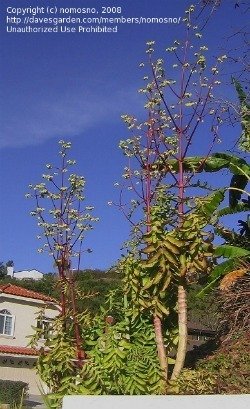
Kalanchoe gastonis-bonnieri blooming in January (left); the very common and super invasive Kalanchoe x Houton's Hybrid (aka Mother of Thousands) cranks out a lot of flowers during the winter (center); and the a flowering Kalanchoe prolifera (right- photo by nomosno)
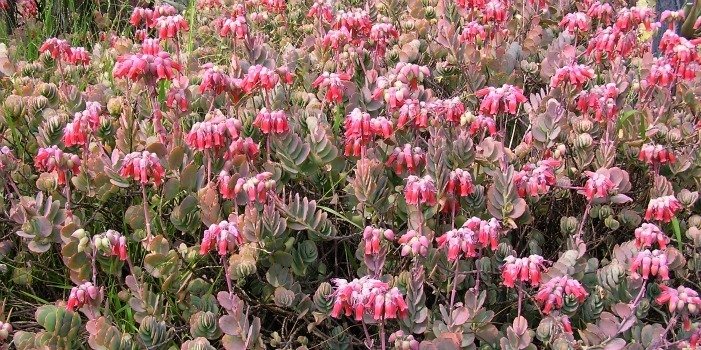
This Kalanchoe marnieriana is one of the Kalanchoes that does not seem to suffer from its flowering experience.
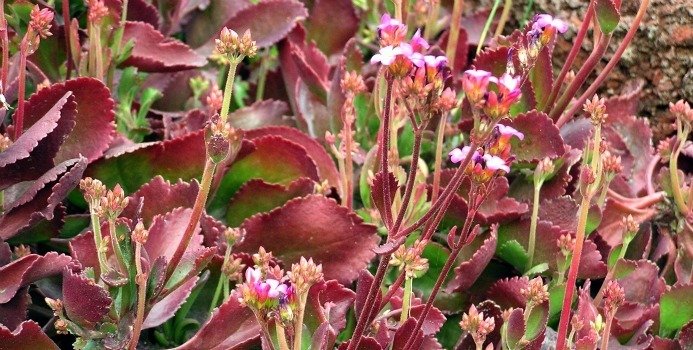
Kalanchoe 'Pink Zinfandel' though not grown particularly for its flowers, does flower this month as well
Mesembs:
There are a few Mesembs that find the cool January weather and shorter day length the best time of year to start making flowers as well. Mesembs are generally very small, but sometimes brilliantly colored African plants in the family Aizoaceae
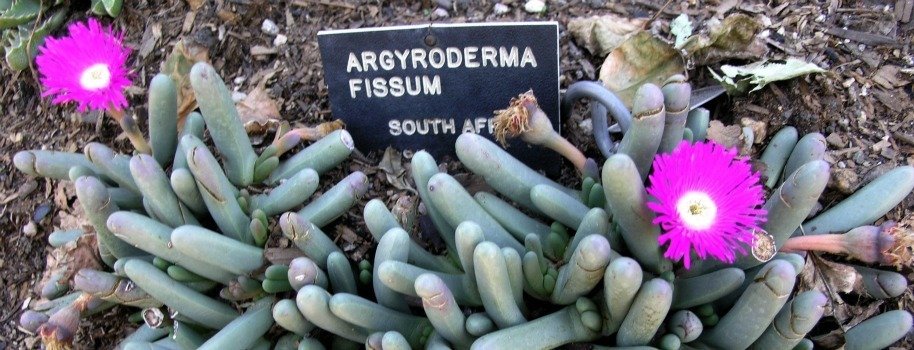
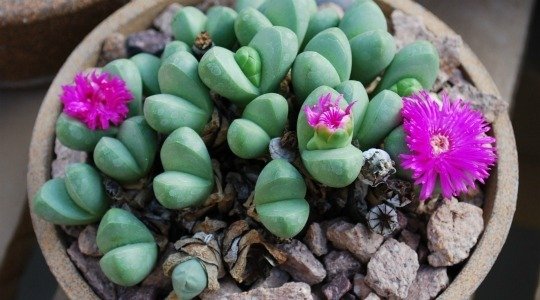
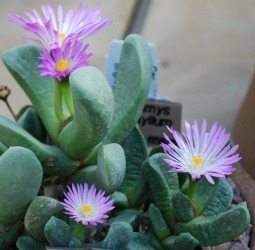
Argyrodermas are often blooming this month (top Argyroderma fissum, left Argyroderma framesii), as well as many other mesembs (right is Cheriodopsis purpurea)
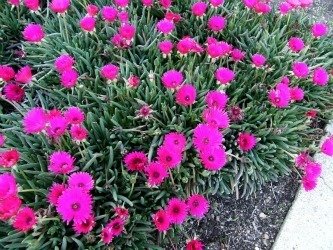
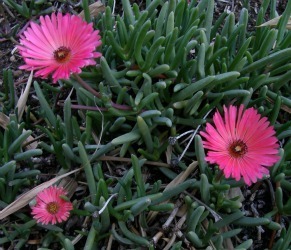

Cephalophyllum 'Red Spike' (left), Cephalophyllum framesii (center) and Cerochlamys pachyphyllum (right)
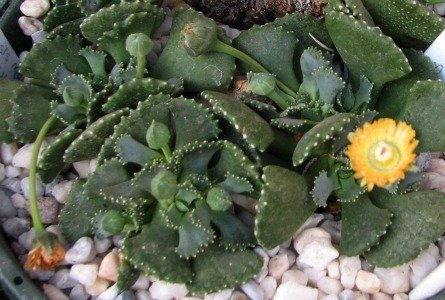 And an Aloinopsis species just to show that not all Mesembs have purple flowers
And an Aloinopsis species just to show that not all Mesembs have purple flowers
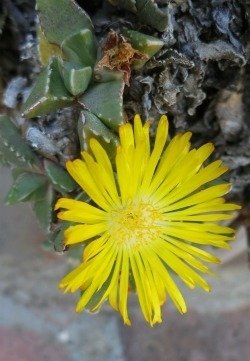
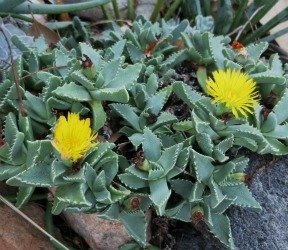
and in my own garden, the Faucarias bloom most evenings in January
Euphorbias:
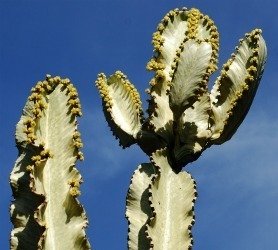
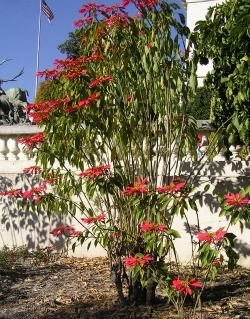
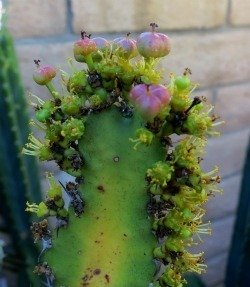
Euphorbia ammak variegated (left); Euphorbia pulcherrima (Poinsettia- center) and Euphoriba triangularis (right) all blooming in January
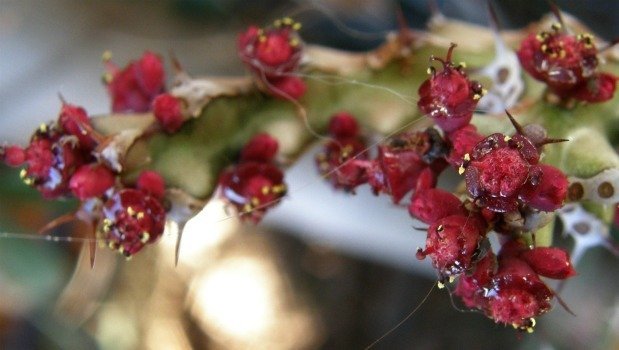 Euphorbia richardsiae with red flowers
Euphorbia richardsiae with red flowers
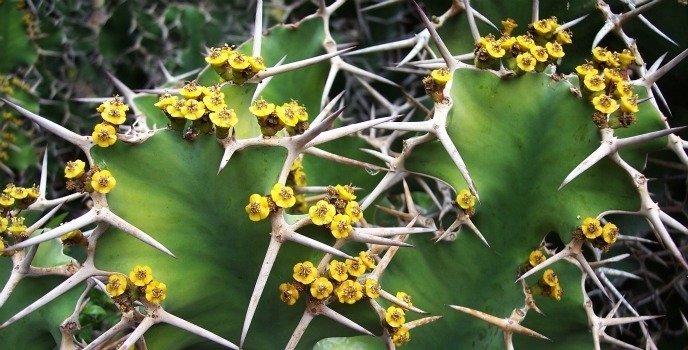 Euphorbia grandicornis
Euphorbia grandicornis
Cacti:
Not much blooming this time of year in the cactus world. Some Mammillarias can occasionally be seen blooming, but I haven't seen them myself. This is primarily a month for quiet, down-time for cacti, but a few Cleistocacti and related genera make blooms in January.
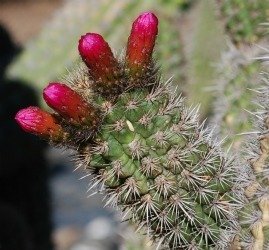
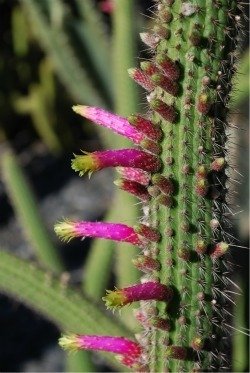
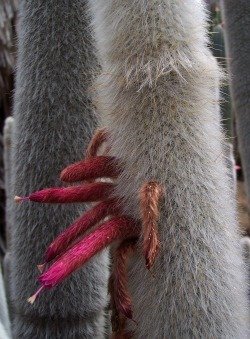
Oreocereus species (left); Cleistocactus ferrarei (center) and Cleistocactus strausii (right)
(Editor's Note: This article was originally published on January 17, 2012. Your comments are welcome, but please be aware that authors of previously published articles may not be able to respond to your questions.)
Copyright © www.100flowers.win Botanic Garden All Rights Reserved